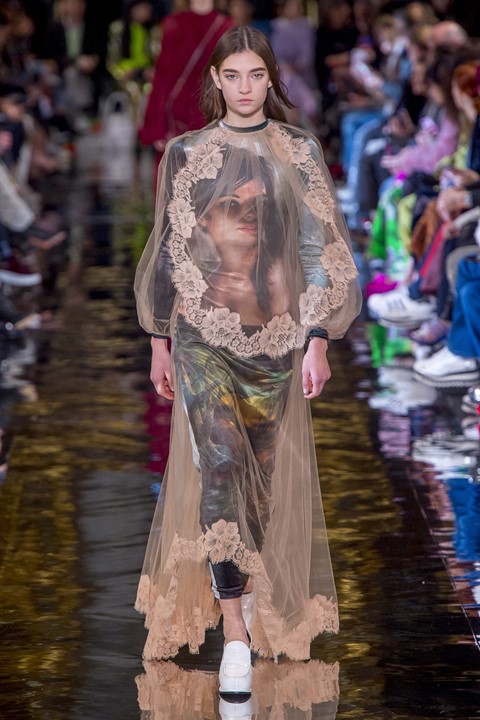J.H. Lynch’s kitsch, mass-produced portraits of voluptuous women provided the prints for the designer’s inside-out collection
The artist Joseph Henry Lynch, slightly better recognised by his signature, J.H. Lynch, is almost entirely unknown – even though his paintings were once so ubiquitous you could buy them in Boots (or the prints, at least). Such was the case for his most remembered work, Tina, named for the voluptuous, kohl-eyed subject, painted in the saturated, sensual style of a B-movie poster.
Tina would go on to decorate the Abigail’s Party-style living rooms of aspirational urbanites in the 1960s onwards, mass-produced in its thousands (some, more generous estimates number millions) alongside Lynch’s other work, similar in both style and subject matter – Woodland Goddess, Nymph and Rose, to name a few. His women are immortalised, if you look closely enough, on the walls of Stanley Kubrick’s domestic interiors in A Clockwork Orange.

Strangely, though his work is lodged in the British cultural psyche, his popularity seemed to obscure the artist himself, to the point he barely seems to have existed. Rumours abound – in some accounts he is not a he at all, but a she – a nun named Julia Lynch from New Zealand – or, a different ‘he’ entirely – a Mexican artist Jesús Helguera. (They have the same initials, and paint in a similar style, or so the theory goes.) In recent years, thanks to the tireless research of Mario Klingemann, who runs jhlynch.org, these rumours have been disproven – J.H. Lynch was simply Joseph Henry Lynch, a British artist who died in 1989 to little fanfare.
In the years since, and with increasing interest in mid-century design, his works have become collectable for their kitsch imaginings of sexuality of the era. It is widely believed he used the archetypal model of the 1960s, Jean Shrimpton, as a basis for his women – but the mysterious identity of his subjects, and of the artist himself, only seems to add to the strange allure of the images.
Stella McCartney succumbed to just that, transposing Tina on to her A/W18 collection in Paris yesterday. Fascinated with the idea of the interiors of clothing – the most intimate parts of clothing; those that touch the skin – taking the linings of tailoring and turning them into diaphanous slip dresses, or stitching them on the exterior of tailored jackets, playing with the tropes of masculine and feminine dress in the process.

The artworks themselves were glimpsed out from beneath blousy layers of tulle and lace. Obscured partially from sight, their latent sense of eroticism seemed to hint of the private desires that a woman might harbour. “We embrace realness here, and definitely sexy. We are not scared of being sexy,” McCartney said of the collection, which propositioned a sexuality of new and old, where bustiers, velvet and lingerie lace met blanket-like swathes of knitwear and patchwork faux fur.
Seductive too were the intensely hued postcards of the 1960s, reprinted here several times over, a counterpoint to Lynch’s women. Together, the prints spoke of the alluring appeal of kitsch – of bad taste made good – and the power it has to enliven a collection. As McCartney herself deemed it backstage – the charm of “something a little bit wrong”.
